Get free scan and check if your device is infected.
Remove it nowTo use full-featured product, you have to purchase a license for Combo Cleaner. Seven days free trial available. Combo Cleaner is owned and operated by RCS LT, the parent company of PCRisk.com.
What is dotnetwork[.]xyz?
Sharing similarities with topernews.me, vakogid.com, viralupdatestoday.com and thousands of others, dotnetwork[.]xyz is a rogue website. It operates by causing rampant redirects to compromised and possibly malicious sites, as well as presenting likewise suspect content for user consumption.
It is noteworthy that few visitors ever access dotnetwork[.]xyz willingly, as most happen upon it by being redirected to it. These redirects can be caused by clicking on intrusive advertisements (most often hosted by untrustworthy sites) or by PUAs (potentially unwanted applications) acting autonomously.
What should be known about these rogue applications, is that they do not require express user permission to be installed onto their devices. Once within a system they cause undesirable redirects, deliver invasive ad campaigns and gather sensitive information.
![dotnetwork[.]xyz pop-up redirects](/images/stories/screenshots201906/dotnetworkxyz-homepage.jpg)
Rogue websites mostly spread through redirects caused by intrusive adverts and by PUAs opening new browser tabs/windows and redirecting users to them. The same mode of spreading applies to dotnetwork[.]xyz as well. Once accessed, it begins its activity by checking visitors' IP (Internet Protocol) address, in order to learn their geolocation.
The latter is crucial to determining this dubious site's further course of action. Once this data is known, it either redirects users elsewhere (to other unreliable, potentially malignant websites) or begins force-feeding them highly questionable content.
Either way, uses entering dotnetwork[.]xyz are bound to encounter untrustworthy material, therefore visiting it is strongly advised against. This site also misuses browser notifications, which if allowed - bring invasive advertisement campaigns.
Even more heinous is the fact, that it attempts to disguise this consent option underneath deceitful click-bait (e.g., "your page is loading, click here to continue"). Intrusive ads themselves are deemed a threat, as they are capable of causing redirects to unreliable/malicious websites, even executing scripts to make rogue downloads/installs of PUAs.
As previously stated, unwanted applications also have the ability to cause redirects and deliver aggressive, intrusive advert campaigns. However, they have gained infamy for their data-tracking abilities.
By monitor user browser activity (URLs visited, pages viewed, search queries typed and etc.), they can gather personal information (IP address, geolocation and identity details). What should be stressed is that this information is then passed onto third parties, seeking to make profit.
Therefore, it is not unlikely that users' vulnerable information can be used for criminal purposes, even culminate in identity theft. In summary, presence of PUAs in one's device can cause serious system and browser infections, as well as severe privacy and identity issues. To ensure user and device safety, all rogue applications must be removed immediately.
| Name | dotnetwork.xyz pop-up |
| Threat Type | Push notifications ads, Unwanted ads, Pop-up ads |
| Detection Names | Forcepoint ThreatSeeker (Suspicious), Full List Of Detections (VirusTotal) |
| Serving IP Address | 184.168.221.62 |
| Symptoms | Seeing advertisements not originating from the sites you are browsing. Intrusive pop-up ads. Decreased Internet browsing speed. |
| Distribution Methods | Deceptive pop-up ads, potentially unwanted applications (adware) |
| Damage | Decreased computer performance, browser tracking - privacy issues, possible additional malware infections. |
| Malware Removal (Windows) |
To eliminate possible malware infections, scan your computer with legitimate antivirus software. Our security researchers recommend using Combo Cleaner. Download Combo CleanerTo use full-featured product, you have to purchase a license for Combo Cleaner. 7 days free trial available. Combo Cleaner is owned and operated by RCS LT, the parent company of PCRisk.com. |
PUAs are vast in their numbers, though many are alike. They often infiltrate devices by offering "useful" and "beneficial" features. However, it must be said that in most cases all listed features turn out to be nonfunctional. Undesired apps are created solely to generate revenue for their developers; to users - they are worthless.
Therefore instead of delivering on any promises, these applications cause unauthorized redirects to dubious/malignant websites, run invasive ad campaigns (e.g. pop-ups, banners, coupons, etc.) and track data.
How did adware install on my computer?
PUAs can slip into systems without user knowledge, through scripts executed by intrusive advertisements. Due to reckless browsing habits (visiting suspicious sites, clicking on various ads) users endanger their devices and themselves. However, users can also unintentionally install unwanted apps themselves.
By downloading programs from untrustworthy places, they can get install bundles pre-packed with PUAs. "Bundling" is a false marketing method, where regular, ordinary software is packed together with rogue applications. While opt-outs are often possible, due to careless approach to the installation process, they can easily be missed.
Ignoring terms, not exploring possible options, step-skipping and using pre-set install settings - can lead to users' devices becoming hosts to PUAs. Aside from any decline options being difficult to find, these apps can also wear the guise of "usefulness" and "functionality".
Although these offered features may sound tempting, it must be reinforced that PUAs are of no genuine value to users. Having such within one's device can expose the system to various infections, even put user privacy and identity at risk.
How to avoid installation of potentially unwanted applications?
All software downloads should be done through official and verified sources, with direct download links getting highest recommendation. Using P2P (peer-to-peer) sharing networks and other third party downloaders should be avoided. Programs downloaded from untrustworthy sources are more likely to be bundled with unwanted applications.
When installing software, proper protocol should be followed. This includes: reading terms, exploring possible options, using "Custom/Advanced" settings, opting-out from installing additional applications/features and declining from downloading such from elsewhere.
Any offers that are considered for acceptance, should be researched in order to verify their legitimacy. Prudent browsing includes avoiding suspicious sites and adverts. It should be known that intrusive ads often appear legitimate and harmless, thereby hindering their identification.
However the sites they redirect to tend to be far from such (e.g. gambling, pornography, adult-dating and similar). Should users encounter ads/redirect of this kind, a system check is highly recommended, followed by swift removal of any dubious applications and/or browser extensions/plug-ins.
If your computer is already infected with rogue applications, we recommend running a scan with Combo Cleaner Antivirus for Windows to automatically eliminate them.
Appearance of dotnetwork[.]xyz website (GIF):
![dotnetwork[.]xyz website appearance (GIF)](/images/stories/screenshots201906/dotnetworkxyz-appearance.gif)
Instant automatic malware removal:
Manual threat removal might be a lengthy and complicated process that requires advanced IT skills. Combo Cleaner is a professional automatic malware removal tool that is recommended to get rid of malware. Download it by clicking the button below:
DOWNLOAD Combo CleanerBy downloading any software listed on this website you agree to our Privacy Policy and Terms of Use. To use full-featured product, you have to purchase a license for Combo Cleaner. 7 days free trial available. Combo Cleaner is owned and operated by RCS LT, the parent company of PCRisk.com.
Quick menu:
- What is dotnetwork.xyz pop-up?
- STEP 1. Remove spam notifications from Google Chrome
- STEP 2. Remove spam notifications from Google Chrome (Android)
- STEP 3. Remove spam notifications from Mozilla Firefox
- STEP 4. Remove spam notifications from Microsoft Edge
- STEP 5. Remove spam notifications from Safari (macOS)
Disable unwanted browser notifications:
Video showing how to disable web browser notifications:
 Remove spam notifications from Google Chrome:
Remove spam notifications from Google Chrome:
Click the Menu button (three dots) on the right upper corner of the screen and select "Settings". In the opened window select "Privacy and security", then click on "Site Settings" and choose "Notifications".
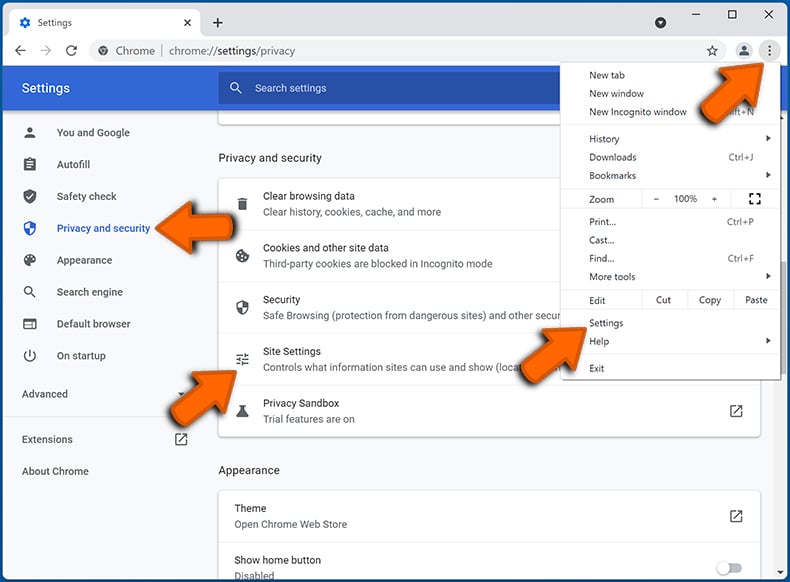
In the "Allowed to send notifications" list search for websites that you want to stop receiving notifications from. Click on the three dots icon near the website URL and click "Block" or "Remove" (if you click "Remove" and visit the malicious site once more, it will ask to enable notifications again).
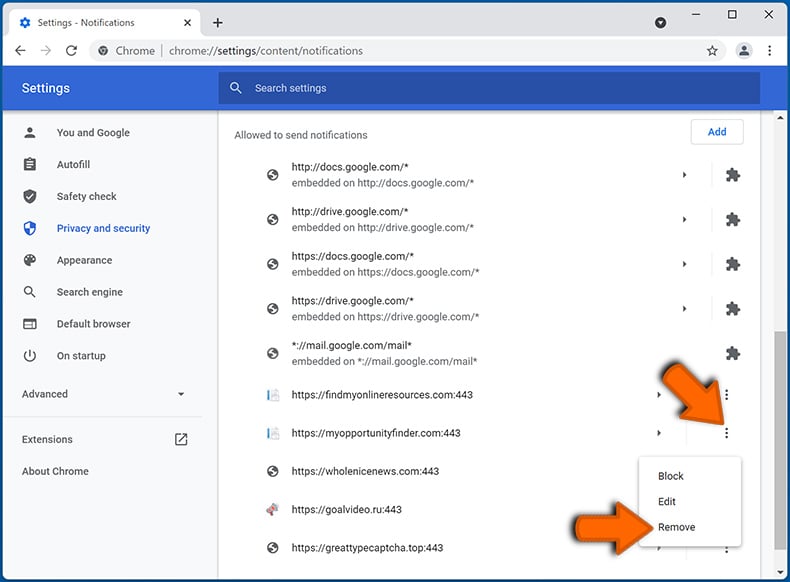
 Remove spam notifications from Google Chrome (Android):
Remove spam notifications from Google Chrome (Android):
Tap the Menu button (three dots) on the right upper corner of the screen and select "Settings". Scroll down, tap on "Site settings" and then "Notifications".
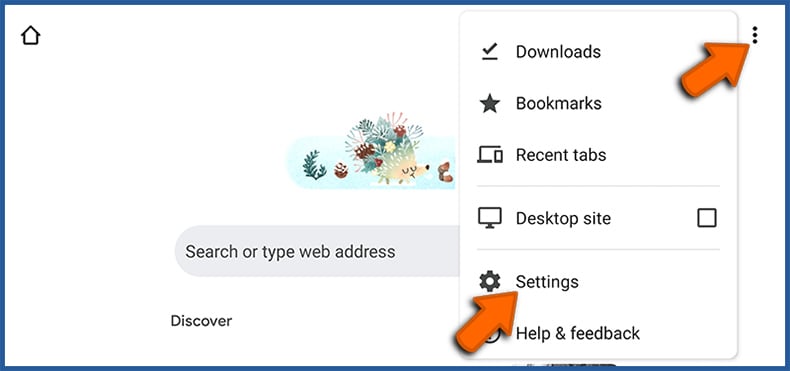
In the opened window, locate all suspicious URLs and tap on them one-by-one. Once the pop-up shows up, select either "Block" or "Remove" (if you tap "Remove" and visit the malicious site once more, it will ask to enable notifications again).
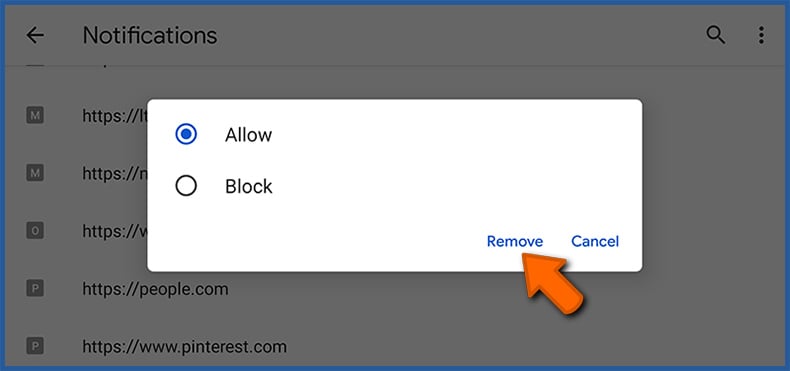
 Remove spam notifications from Mozilla Firefox:
Remove spam notifications from Mozilla Firefox:
Click the Menu button (three bars) on the right upper corner of the screen. Select "Settings" and click on "Privacy & Security" in the toolbar on the left hand side of the screen. Scroll down to the "Permissions" section and click the "Settings" button next to "Notifications".
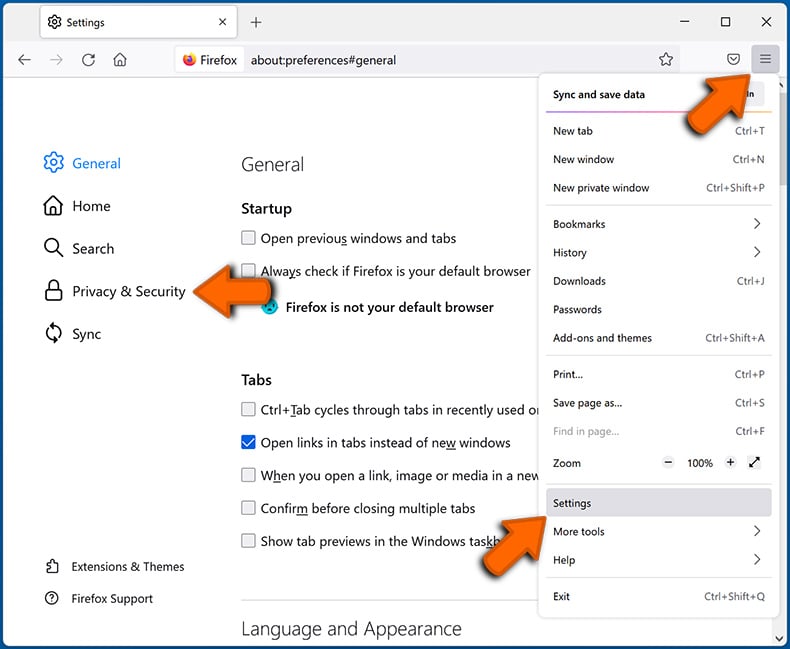
In the opened window, locate all suspicious URLs and block them using the drop-down menu or either remove them by clicking "Remove Website" at the bottom of the window (if you click "Remove Website" and visit the malicious site once more, it will ask to enable notifications again).
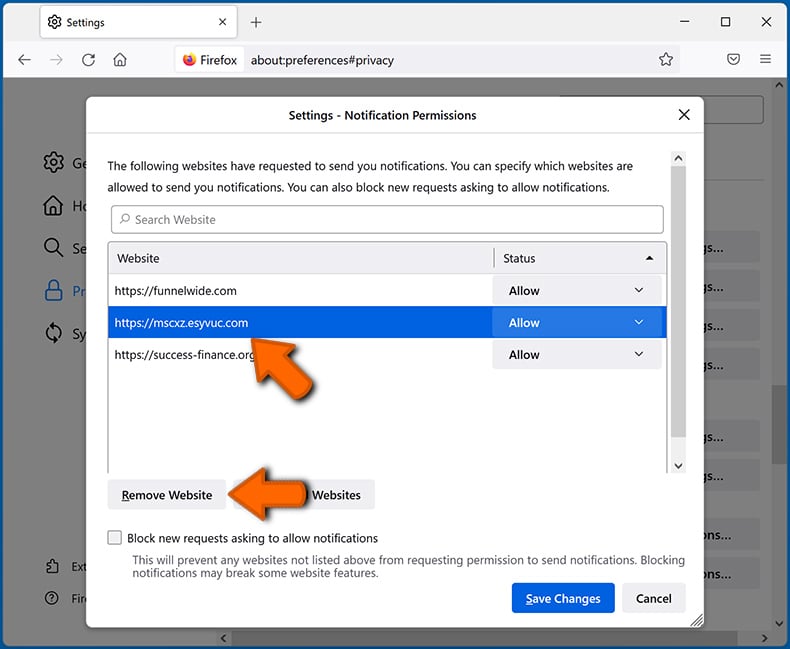
 Remove spam notifications from Microsoft Edge:
Remove spam notifications from Microsoft Edge:
Click the menu button (three dots) on the right upper corner of the Edge window and select "Settings". Click on "Cookies and site permissions" in the toolbar on the left hand side of the screen and select "Notifications".
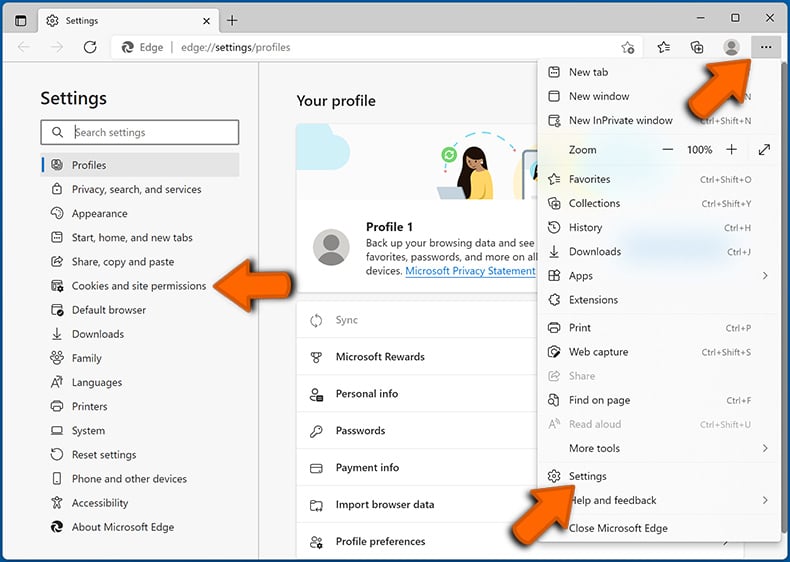
Click three dots on the right hand side of each suspicious URL under "Allow" section and click "Block" or "Remove" (if you click "Remove" and visit the malicious site once more, it will ask to enable notifications again).
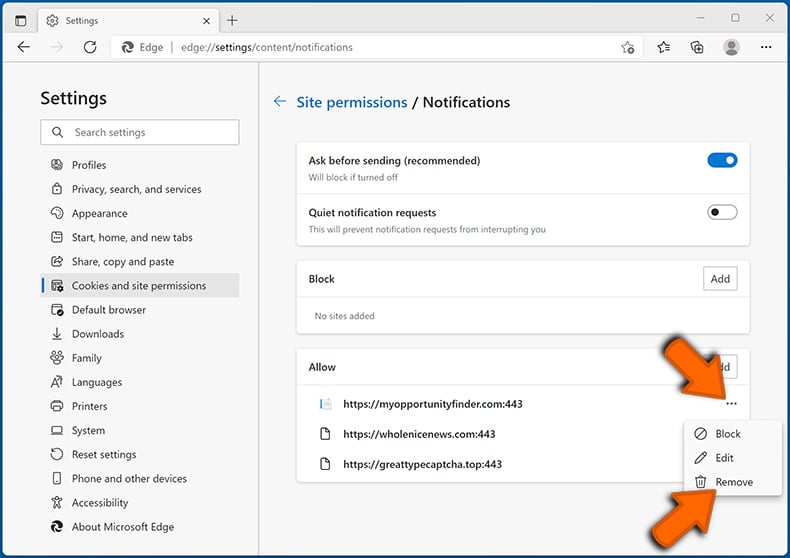
 Remove spam notifications from Safari (macOS):
Remove spam notifications from Safari (macOS):
Click "Safari" button on the left upper corner of the screen and select "Preferences...". Select the "Websites" tab and then select "Notifications" section on the left pane.
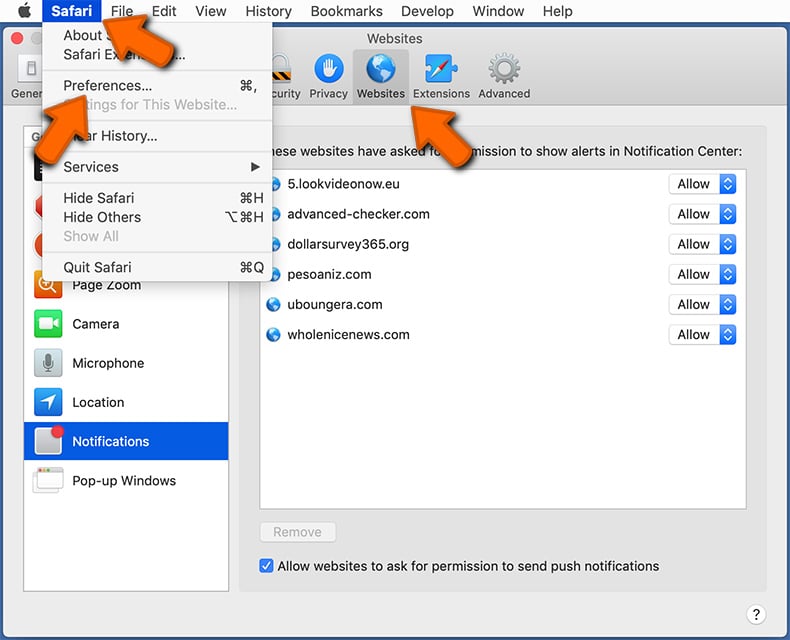
Check for suspicious URLs and apply the "Deny" option using the drop-down menu or either remove them by clicking "Remove" at the bottom of the window (if you click "Remove" and visit the malicious site once more, it will ask to enable notifications again)
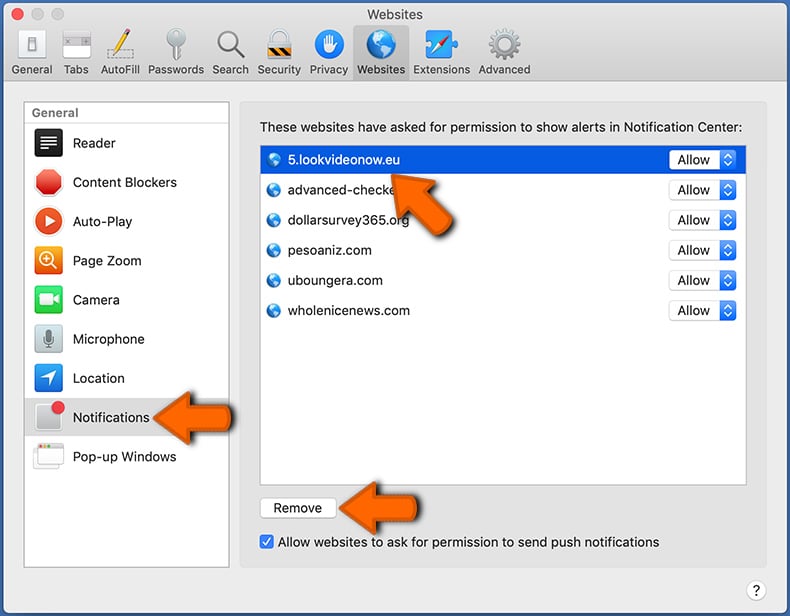
How to avoid browser notification spam?
Internet users should be very skeptical when being asked to allow notifications. While this is a useful feature that allows you to receive timely news from websites you like, deceptive marketers frequently abuse it.
Only allow notifications from websites that you fully trust. For added security - use an anti-malware application with a real-time web browsing monitor to block shady websites that tries to trick you into allowing spam notifications. We recommend using Combo Cleaner Antivirus for Windows.
Share:

Tomas Meskauskas
Expert security researcher, professional malware analyst
I am passionate about computer security and technology. I have an experience of over 10 years working in various companies related to computer technical issue solving and Internet security. I have been working as an author and editor for pcrisk.com since 2010. Follow me on Twitter and LinkedIn to stay informed about the latest online security threats.
PCrisk security portal is brought by a company RCS LT.
Joined forces of security researchers help educate computer users about the latest online security threats. More information about the company RCS LT.
Our malware removal guides are free. However, if you want to support us you can send us a donation.
DonatePCrisk security portal is brought by a company RCS LT.
Joined forces of security researchers help educate computer users about the latest online security threats. More information about the company RCS LT.
Our malware removal guides are free. However, if you want to support us you can send us a donation.
Donate
▼ Show Discussion